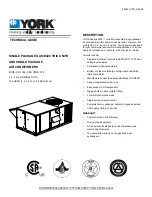
9
D
F
I
NL
E
P
GR
RU
TR
GB
7.1. Power supply wiring
•
Power supply cords of appliances shall not be lighter than design 245 IEC 57 or 227 IEC 57.
•
A switch with at least 3 mm contact separation in each pole shall be provided by the Air conditioner installation.
[Fig. 7.1.1] (P.3)
A
Ground-fault interrupter
B
Local switch/Wiring breaker
C
Indoor unit
[Selecting non-fuse breaker (NF) or earth leakage breaker (NV)]
To select NF or NV instead of a combination of Class B fuse with switch, use the following:
•
In the case of Class B fuse rated 15 A or 20 A,
NF model name (MITSUBISHI): NF30-CS (15 A) (20 A)
NV model name (MITSUBISHI): NV30-CA (15 A) (20 A)
Use an earth leakage breaker with a sensitivity of less than 30 mA 0.1 s.
Caution:
Do not use anything other than the correct capacity breaker and fuse. Using fuse, wire or copper wire with too large capacity may cause a risk of malfunction or
fire.
7.2. Connecting remote controller, indoor
and outdoor transmission cables
(Remote controller is optionally available.)
•
Connect indoor unit TB5 and outdoor unit TB3. (Non-polarized 2-wire)
The “S” on indoor unit TB5 is a shielding wire connection. For specifications
about the connecting cables, refer to the outdoor unit installation manual.
•
Install a remote controller following the manual supplied with the remote con-
troller.
•
Connect the “1” and “2” on indoor unit TB15 to a MA remote controller. (Non-
polarized 2-wire)
•
Connect the “M1” and “M2” on indoor unit TB5 to a M-NET remote controller.
(Non-polarized 2-wire)
•
Connect the remote controller’s transmission cable within 10 m using a 0.75 mm
2
core cable. If the distance is more than 10 m, use a 1.25 mm
2
junction cable.
[Fig. 7.2.1]
(P.4) MA Remote controller
[Fig. 7.2.2]
(P.4) M-NET Remote controller
A
Terminal block for indoor transmission cable
B
Terminal block for outdoor transmission cable
C
Remote controller
•
DC 9 to 13 V between 1 and 2 (MA remote controller)
•
DC 24 to 30 V between M1 and M2 (M-NET remote controller)
[Fig. 7.2.3]
(P.4) MA Remote controller
[Fig. 7.2.4]
(P.4) M-NET Remote controller
A
Non-polarized
B
TB15
C
Remote Controller
D
TB5
Transmission cable specifications
Type of cable
Transmission cables
Shielding wire (2-core)
CVVS, CPEVS or MVVS
ME Remote controller cables
MA Remote controller cables
Sheathed 2-core cable (unshielded) CVV
Cable diameter
More than 1.25 mm
2
0.3 ~ 1.25 mm
2
(0.75 ~ 1.25 mm
2
)*1
0.3 ~ 1.25 mm
2
(0.75 ~ 1.25 mm
2
)*1
Max length: 200 m
Maximum length of transmission lines for centralized control and indoor/
outdoor transmission lines (Maximum length via indoor units): 500 m MAX
The maximum length of the wiring between power supply unit for
transmission lines (on the transmission lines for centralized control) and
each outdoor unit and system controller is 200 m.
Max length: 200 m
When 10 m is exceeded, use
cables with the same specifica-
tion as transmission cables.
Remarks
*1 Connected with simple remote controller.
CVVS, MVVS: PVC insulated PVC jacketed shielded control cable
CPEVS: PE insulated PVC jacketed shielded communication cable
CVV: PVC insulated PVC sheathed control cable
*1 The Ground-fault interrupter should support Inverter circuit. (e.g. Mitsubishi Electric's NV-C series or equivalent).
*2 Ground-fault interrupter should combine using of local switch or wiring breaker.
*3 It shows data for B-type fuse of the breaker for current leakage.
Earth wire
<mm
2
>
Power wire
<mm
2
>
(Non-fuse breaker)
<A>
Indoor unit
15 A 30 mA 0.1sec. or less
Breaker capacity
<A>
Over-current protector*3
<A>
Minimum Wire thickness
Wiring breaker
Ground-fault interrupter
*1, *2
Local switch
2
2
16
16
16
•
The MA remote controller and the M-NET remote controller cannot be used at
the same time or interchangeably.
Note:
Ensure that the wiring is not pinched when fitting the terminal box cover.
Pinching the wiring may cut it.
Caution:
Install wiring so that it is not tight and under tension. Wiring under tension
may break, or overheat and burn.
•
Fix power source wiring to control box by using buffer bushing for tensile force.
(PG connection or the like.) Connect transmission wiring to transmission ter-
minal block through the knockout hole of control box using ordinary bushing.
•
After wiring is complete, make sure again that there is no slack on the connec-
tions, and attach the cover onto the control box in the reverse order removal.
Caution:
Wire the power supply so that no tension is imparted. Otherwise disconnec-
tion, heating or fire result.
Note:
Put the transmission cable earth via the outdoor unit’s earth terminal
to
the ground.
[Constraints on transmission cable]
[Fig. 7.2.5]
(P.4)
G
Outdoor unit
H
Earth
I
Indoor unit
J
Remote controller
K
Non-polarized 2-wire





























